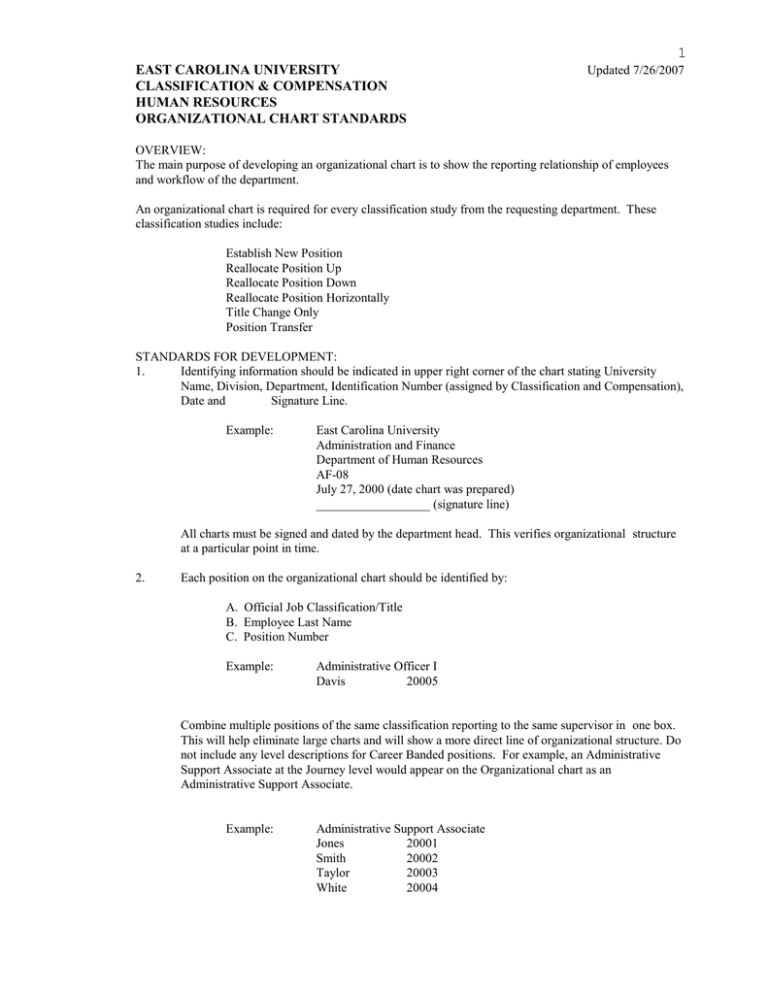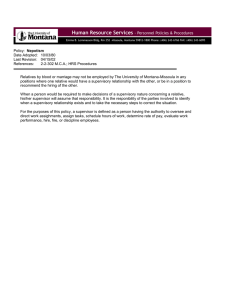ECU Organizational Chart Standards
advertisement

1 EAST CAROLINA UNIVERSITY CLASSIFICATION & COMPENSATION HUMAN RESOURCES ORGANIZATIONAL CHART STANDARDS Updated 7/26/2007 OVERVIEW: The main purpose of developing an organizational chart is to show the reporting relationship of employees and workflow of the department. An organizational chart is required for every classification study from the requesting department. These classification studies include: Establish New Position Reallocate Position Up Reallocate Position Down Reallocate Position Horizontally Title Change Only Position Transfer STANDARDS FOR DEVELOPMENT: 1. Identifying information should be indicated in upper right corner of the chart stating University Name, Division, Department, Identification Number (assigned by Classification and Compensation), Date and Signature Line. Example: East Carolina University Administration and Finance Department of Human Resources AF-08 July 27, 2000 (date chart was prepared) __________________ (signature line) All charts must be signed and dated by the department head. This verifies organizational structure at a particular point in time. 2. Each position on the organizational chart should be identified by: A. Official Job Classification/Title B. Employee Last Name C. Position Number Example: Administrative Officer I Davis 20005 Combine multiple positions of the same classification reporting to the same supervisor in one box. This will help eliminate large charts and will show a more direct line of organizational structure. Do not include any level descriptions for Career Banded positions. For example, an Administrative Support Associate at the Journey level would appear on the Organizational chart as an Administrative Support Associate. Example: Administrative Support Associate Jones 20001 Smith 20002 Taylor 20003 White 20004 2 Organizational Chart Standards Working titles will only be accepted on the chart as an addition to the Official Classification Title. 3. In identifying the reporting relationship of the position, it should be the individual giving the performance evaluation. The ECU-One Form should always reflect the same Name and Title of the immediate Supervisor as shown on the organizational chart. 4. Lines between positions should indicate actual supervisory relationships, that is, review of general job performance. Many positions relate to more than one other position. This should be explained in each job description not on the chart. 5. All charts must be on an 8 1/2 by 11 sheet of paper. No multiple pages. For large departments you can utilize reduction features and/or cut and paste techniques. 6. The chart should be sufficiently clear so that someone not familiar with your area can understand it. 7. Identification symbols generally used on charts: ______ Indicates direct line management or supervisory relationships. --------- Indicates indirect management or supervisory relationships. * Indicates special notations (shown in block as a footnote). 8. “Graphics” should be kept simple for clarity. Rectangle shapes are recommended as they have the cleanest lines and allow maximum space for information. Circles, diamonds and octagons, etc. appear decorative, but have no meaning and are usually confusing in showing distinct reporting relationships. We strongly recommend using only rectangular shapes. 9. “Proposed Positions” should be clearly identified on the chart submitted from the Department. This may be done by noting “Proposed” in the block and then highlighting it with a marker to make it more visible. The proposed position should be organizationally structured on the chart in relation to the supervisor indicated on the ECU-118 Form. Highlighting the position for any action will be helpful to immediately locate it on the chart. 10. Any personnel turnover in positions not affected by the requested action should also be made on the chart. Include any and all vacant positions i.e. frozen positions, grant/inactive/expired funded positions that have not been abolished. 11. As actions are completed, the Department of Human Resources will make the manual changes on their file copy. This will include, but not limited to, proposed position approvals, mass number changes, abolished positions, etc. 12. When an action affects more than one chart, each department should submit an updated O-chart to the Department of Human Resources. 13. Subunits should be identified by unit name on the chart for each area. For example, the Department of Human Resources has several subunits which are identified on the chart as Recruitment, Benefits, Classification, Information/Processing Center, etc. 14. A narrative explanation will have to accompany the chart to explain when there has been a reorganization and/or changes in reporting relationships.



